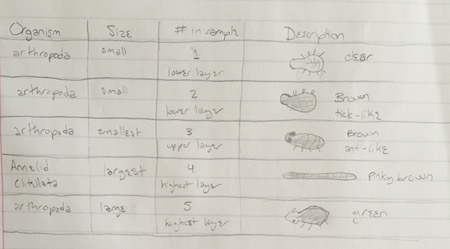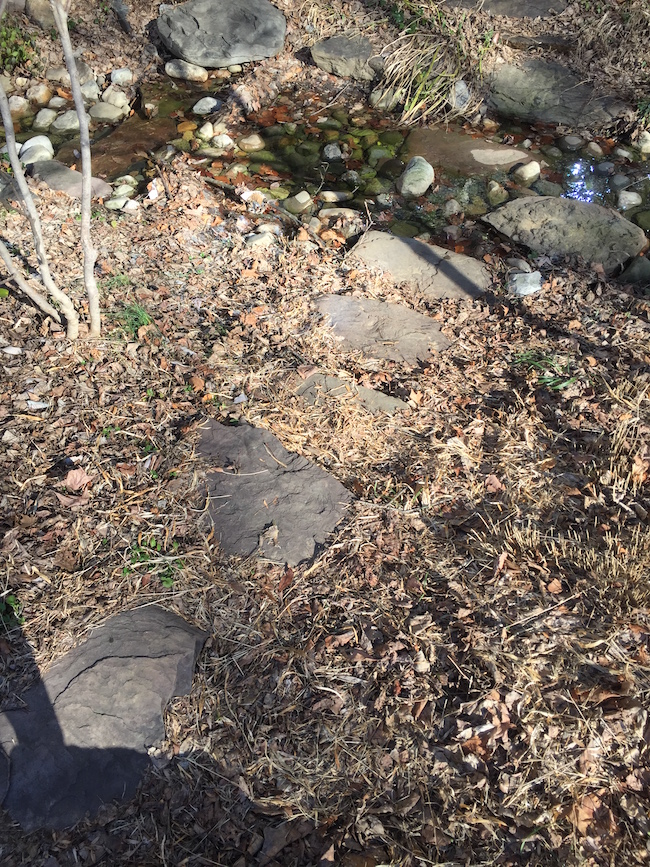User:Allison Murk/Notebook/Biology 210 at AU/2016/01/13
Lab 6: Embryonic Development & Zebrafish Experiment, February 17th, 2016Embryonic Development Figure 1. Chart comparing embryonic development across species
We are testing the effects of epinephrine on the zebrafish. 24 zebrafish embryos were placed in 2mLs of the control, and 24 zebrafish embryos were placed in 2mLs of the epinephrine treatment. We hypothesize that if the zebrafish embryos are exposed to epinephrine, they will have a different behavioral pattern and increased heart rate. Day 1: 24 hours old, 4-8 somites stage Day 3: 11 of the control embryos were replaced and 1 of the experimental embryos was replaced -- all marked
Lab 5: Berlese Funnel Invertebrate Observations & Vertebrates, February 10th, 2016Analyzing Invertebrate Samples from the Berlese Funnel Figure 1. Description of 5 invertebrates observed
Vertebrates that would live in transect 2 are the American Robin, the Cardinal, the Mourning Dove, the Sparrow, and the Tree Squirrel. American Robin - Chordata Aves Passeriformes Turdidae Turdus T. migratorius Cardinal - Chordata Aves Passeriformes Cardinalidae Cardinalis C. Cardinalis Mourning Dove - Chordata Aves Columbiformes Columbidae Zenaida Z. macroura Sparrow - Chordata Aves Passeriformes Passeridae Passer P. domesticus Tree Squirrel - Chordata Mammalia Rodentia Sciuridae Sciurini All of these vertebrates would be attracted to the creek that runs through the transect fro water, as well as the tall trees, bushes, and general shubbery that birds and squirrels typically live in. In addition, there are other invertebrates such as worms that birds feed from and acorns from the trees for squirrels. Figure 2. Proposed food web for transect 2
Lab 4: Transect 2 Plant & Fungi Observations, February 3rd, 2016Collecting & Analyzing the Plant Samples Transect 2 was flooded due to the rain, and the temperature was 48F. Five plant samples were collected around the transect. Figure 1. Five plant samples collected from transect 2
Figure 2. Observed plant characteristics
Sporangia are important to fungi reproduction since they are where spores form. Figure 3. Drawing of observed fungi
Lab 3: HIC Observations & Microorganism Observations, January 27th, 2016Hay Infusion Culture Observations After the second week the Hay Infusion Culture has continued to decay. The water level has lowered by about an inch, and the water appears clearer, however the top of the water is more crowded with debris. The smell continues to smell like death and decay, and the jar appears to have grown some mold. If the microorganisms in the water continue to breakdown the debris in the water, then the smell and appearance will continue to change. Archaea will not be present in the Hay Infusion or on the agar plates because the conditions are not extreme enough.
Figure 1. Table showing amount of bacterial colonies
Figure 2. Observations from the four sampled bacterial colonies Figure 3. Sampled bacterial colony drawings at 40x magnification
Chopra, I., & Roberts, M. (2001). "Tetracycline Antibiotics: Mode of Action, Applications, Molecular Biology, and Epidemiology of Bacterial Resistance." Microbiology and Molecular Biology Reviews, 65(2), 232–260. http://doi.org/10.1128/MMBR.65.2.232-260.2001
Lab 2: Hay Infusion Culture Observations & Serial Dilutions, January 20th, 2016Hay Infusion Culture Observations After 1 week the Hay Infusion appeared relatively the same as the first week with the exception of a thin film coating the top of the water and some possible mold growth. The water was murky and filled with the debris from last week. Despite the lack of difference in appearance, the smell drastically changed. The Hay Infusion had the smell of rot and extreme bacterial growth. If the Hay Infusion were to be left for two more months, I would expect more growth, but selective factors such as the amount of nutrients would start to become more apparent. Figure 1. Drawings of protists observed from the Hay Infusion Culture
Paramecium meet all the requirements of life for energy, cells, information, replication, and evolution. Paramecium obtain energy from dead plant matter. They are also single-celled organisms with macronuclei for processes such as digestion and protein synthesis. Paramecium have genetic information that is conserved after replication by binary fission or sexually by conjugation which is an evolution to sexual dimorphism.
Figure 2. Diagram of serial dilution concentrations
Lab 1: Examining a Transect at AU, January 13th, 2016Purpose: The purpose of this lab was to observe a 20 x 20 ft transect on AU's campus, and to collect samples from the transect to be used in a Hay Infusion. Our hypothesis for the Hay Infusion is that there will be organism growth.
Figure 1. Aerial Drawing of transect 2. Figure 2. Panoramic view of transect 2. Figure 3. Picture of water area of transect 2.
~AM
|
|













